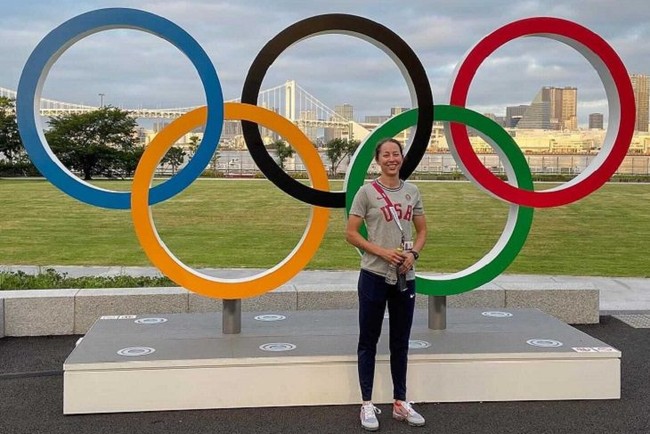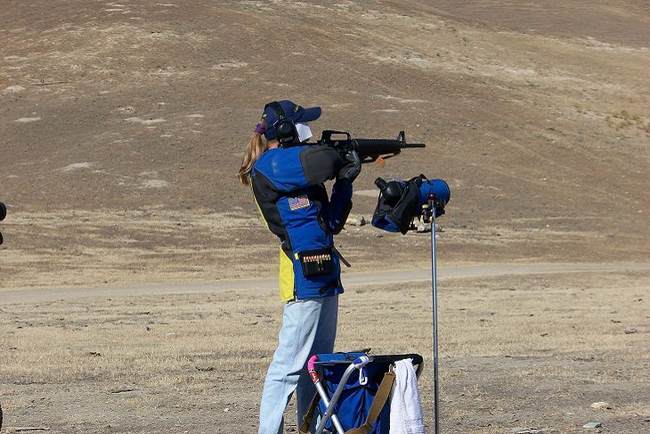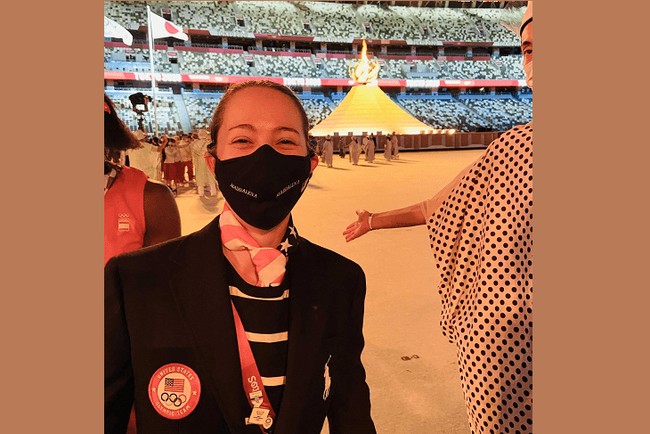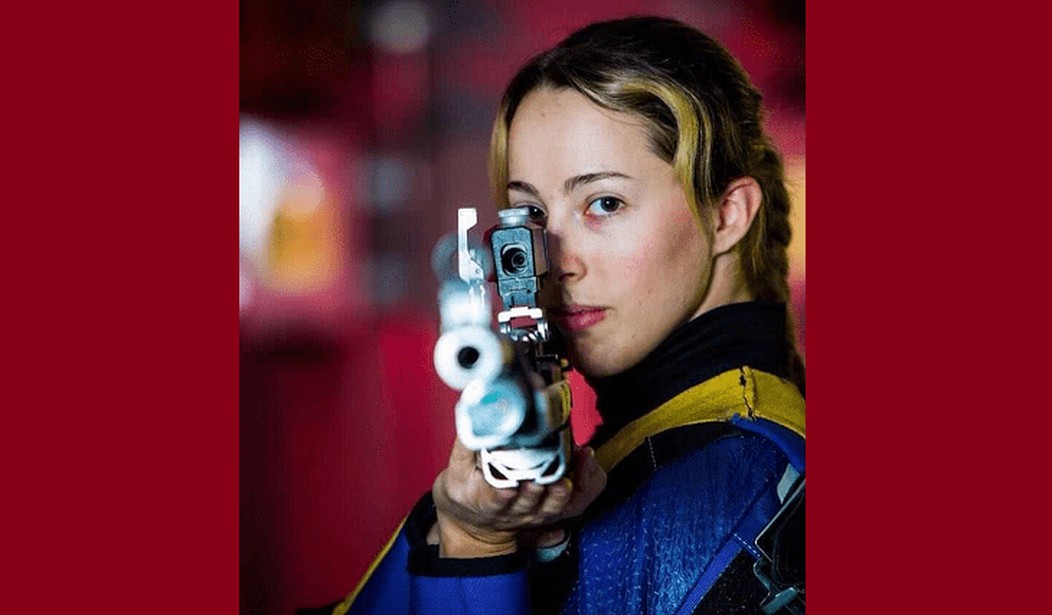Let the Tokyo Olympics begin. California-born Sagen Maddalena will be representing the United States of America shooting in the 50-meter Rifle Three Position Women’s event. I interviewed her on the morning of Opening Ceremony day. I first met Sagen Maddalena on the California service rifle competition fields in Coalinga, California. She was a member of the California Grizzlies Junior High Power Rifle Team that competes at the US National Matches at Camp Perry, Ohio. At 5′ 4″ and 110 pounds, Sagen is a powerhouse that literally takes the slogan “Shoot like a girl” to Olympic proportions. She’s always been able to outshoot me, and almost everyone else I know.
She has unusual talent and focus, not just at shooting, but at life itself. That drive has led her to the Olympic Games representing her country. I could write an introductory bio, but I think this quote from another highly talented fellow competitive shooter says it best,
“There is a young woman who is one of the fiercest shooting competitors I have ever met and had the honor of shooting next to. She also happens to live near the Central Valley in Groveland, Ca. Sagen Maddalena worked her way through the Ca junior high power shooting program, which led her to a shooting scholarship in Alaska, eventually paving the way to a career in the prestigious Army Marksmanship Unit. This small power house of a woman can pick up a chain saw and out cut you with it, pick up a fly rod and out fish you with it, then pick up a rifle and straight up put you to shame with it!” – Jarred Perry
The 50-meter Rifle Three Position Women’s matches start on July 31st.
The Interview

DS: First of all congratulations. We’ll start with the first obvious question. So, how does it feel to be at the Olympics?
SM: It is unreal. I mean I’ve trained for it and put in so much effort to where it’s not like it’s a surprise being here in the Olympic Village. But I’m sitting on my balcony right now, just looking out and it almost feels like it is just like something in the future. Even though I like I’m living it in person, it just seems so unreal. In my mind, I’m like, hey man, you got to hurry up, we’re here. It’s time to live in the present.
DS: So what’s it like in the village?
SM: There are a lot of people who are in very good shape. It’s awesome because I’m seeing people of all different shapes, sizes, and nationalities. It’s just amazing to be around everyone in such a small area. I mean, it’s actually a huge area, but looking at it worldwide we’re just in such a small little niche. It’s neat to be around all these different cultures and people. I think the best. It’s also very humbling just to walk around the village and to be around so many people that are; I mean like, they’re the best in their sports. Yeah, I think humbling is the best word to describe it.
DS: Yeah, I get that. It is very special to be in such company. But you know, the fact is that if you look in the mirror, you are one of those people! As far as the United States of America is concerned, you are the best in your sport, one of the faces of our nation at the Olympic Games. And you’ve always been humble. When I first met you, you were a kid shooting service rifle matches in the fields of Coalinga. It’s been quite a journey from there, hasn’t it? All the places you’ve been on your journey of competitive shooting; the California Grizzlies, the University of Alaska, the US Army Marksmanship Unit, and here you are at the Olympics. But you know that I know you first as a fellow shooter. So I’m going to ask you, how’s your game? Where’s your focus? What’s going on with Sagen Maddalena, the competitor, right now?
SM: Yeah, you know I very much believe in my training plan leading up to the match and through the match. Before we even departed for here, I’d been on this “periodization plan” (a series of training blocks) for all of last year. It really has become a routine that I can trust. I think that’s the huge confidence boost for me.
The only thing that’s a little different that I am currently going over in my mind planning for is the range we have for the 50-meter event. My event is on the same range for the 10-meter event. They have their pre-event training today. They compete starting tomorrow and for the next four days. Because of that, the 50-meter people like myself don’t have access to a range. We aren’t able to practice for the next five days. So today, and the four days after that, we can’t actually step onto the line, aim, and execute live shots. So that is a little different.
However, once the range opens up, I’ll have a solid four days before competition. And that is how my training blocks have been working every week for the last year.
Starting Monday, I’ve got my SCATT* day. Tuesday, the second day of the work-up block, is my day to get rounds downrange. Whether it’s time and position training or quantity/quality of shots training, I’m able to focus on that for a day. Then on the third day, Wednesday, that’s fine-tune session. We’ll be doing intensity drills. We’ll be doing practice matches. Then the fourth day, Thursday, it’s time to compete.
*The SCATT is an electronic training device used by shooters to practice shooting without ammunition known as dry fire practice. The SCATT contains sensors that can provide intricate feedback on every movement of the gun from the time the competitor mounts it, through taking the shot, and beyond into the follow-through phase after the shot.
And so, all of that really works out to where when the range opens up, I have those four days. So I’m going to treat it just like I have been in my training blocks at home. So that really gives me a confidence boost. I’m saying, hey you know, this is what we’ve got. Nothing has really changed. The only thing that’s different is I’m in a different country.
So looking at my authentic average over the last year, if we look at actual outcome, it’s world-class and has been for the last year. I am really looking forward to the chance to compete and put it out there and see, you know? There is no luck in it, which is really cool. I just have go out and shoot and be me. I don’t have to shoot something beyond my ability to be competitive here.
DS: I’ve had other friends over the years that were pursuing Olympic training and it’s amazing how it just takes over everything of their being for a year or two. It takes total focus. That’s the inner game of competition right there.
SM: Oh yeah. The crazy thing for people on the outside I think is they just see the range time or the venue time, the time you compete and train. But, it’s a lifestyle. The time that you go to bed is almost set in stone. The time you get up is set. When you work out. When you eat. What you eat. Who you even hang out with, you know? The characteristics of people that keep help you keep your edge, and like you said, you do it for a year, or for us, we’ve had it extended a year. So you have to keep that going. There’s a lot of sacrifice that is being made to have control, but at the same time, complete flexibility in the training process.
DS: Well that the hallmark of a world-class competitor right there. Most impressive indeed. So here’s my next question. Look back on this journey, and you can look back as far as you want. I mean we both literally started part of our early shooting careers in the middle of a cow field. The ups and downs. The frustrations and the breakthroughs. How would you sum up the journey so far? Because it really is an extraordinary Journey.

SM: Oh goodness. You know, I have a passion for what I do and really latching on to the progression of it. Like while you were talking and I was listening to you, one of the memories that comes up and keeps coming up is when Steve Finnigan, back at the .22 program in Jamestown, before I was even on the California Grizzlies service rifle team. And I was just doing the two-day-a-week .22 program at the Motherlode Gun Club. And, when I finally moved up to the advanced group, when we could actually shoot standing, we could get on our feet, because it was just prone and standing at Motherlode. I don’t remember if we had sitting, but mainly, I remember prone and standing. And Steve said that to shoot standing, you have to love it. To be good at it, you have to learn to love it; and I was like, I could do that.
People always say that I’m a natural shooter. They didn’t see behind the scenes, you know? I was not a natural shooter. I was just naturally good at working hard. And so, once I learned to love standing then I just latched onto it, to love it. After all these years, I’ve never really let go of enjoying shooting standing. It’s still my favorite part of any match.
So I’m just loving what I do and having a true connection with it. Even on the bad days, when the emotions are spiking and it’s like, man what am I doing? And then it’s like, no, I really do love it. I even love the hard days. Well, I don’t love them when they’re happening, but it’s all part of that growth and I wouldn’t take back any of these years that have gone into the preparation and training.
DS: I hear you, Sagen. I wouldn’t take back any step of my shooting journey either. Even all those repetitions where the SCATT keeps giving feedback repeatedly that to the last shot you made sucked. Failure is still learning.
SM: Yeah. And you know what, 30 minutes before I called you, I was sitting on my balcony and I’m going through my SCATT files from the training from two days ago and evaluating them. I was looking at them and, like, okay, you know, at the time I thought these were good but my NPA is off. Clearly. I can see that trace coming up from the right side; and I said, okay these were good shots, but let’s fix that NPA and the triggering number is going to improve and the shots are going to be on-call better. And so yeah, it’s all about living in the moment, but not being afraid to evaluate how change is going to keep that Improvement moving forward.
DS: Yeah man. So here’s my trivia question that I ask all the really good offhand (standing) shooters. And by the way, I’m finally learning to love it after all these, too. I totally get that, once you do find that little magic formula in your head that makes it work, it starts to become fun and you do fall in love with it. So, here’s my trivia question. How many steps are there in your process for each shot in offhand?
SM: It is subconscious at this point. But consciously, back in the day, it was two pieces of paper. Like those college-ruled single-spaced when I would sit there and evaluate the process and write it all down, yeah, two pieces of paper.
DS: So that’s somewhere around 50 to 60 steps?
SM: Yeah.
DS: That’s about the average I’ve heard. What is it like now?
SM: Now it’s, “Is my balance right?” and it’s “Is my NPA right?” Then I can let my body perform. So, it’s gone from two pages of paper of a process to two things I’m conscious of. Of course, there’s a lot of things that contribute to that, but in the end, it really just comes down to those two parts of the process.
*NPA – natural point of aim
DS: So you’ve turned all those other steps into a reflex at this point.
SM: Yes.
DS: Very nice. That’s cool, Sagen. I mean, you know kid, I’m still impressed about that time you told me that you don’t move your rear sight on your AR going from 300 to 600 yards, you move the front side because you don’t want to change your head position on the gun.
SM: Yeah, yep.
DS: All right, we’ll move. It’s Opening Ceremony today right?
SM: It is tonight. They’ve got us walking out.
DS: Are you excited?
SM: Oh yeah, I am. Not too excited because it is dipping into my sleeping time. We won’t depart the Village until 2100h, so, we don’t get back until pretty late. I do want the sleep, but hey, I’ll sacrifice a little bit. It is a once-in-a-lifetime experience.

DS: So obviously there’s a lot of people that are pulling for you at this point. I looked at your social media and all the top shooters turning up wishing you well. And you know, it’s a very big community. Most people don’t realize competitive shooters are a huge family that supports each other. You got a message for everybody that’s cheering for you? What’s your message for all those people at the US Nationals at Camp Perry on the Viale and Rodriguez ranges going, “I wonder how Sagen is doing?”
SM: I’m thinking. I’m thinking right now. Because it’s one of those things where you just get caught up and the selfness of focusing and you don’t have much time to think about, you know, all those people where you come from.
DS: It’s because you’re in your zone right now, aren’t you?
SM: Yeah. But there is a huge piece of me when I kind of like I’m able to kind of sit back and take that a little bit of a breath and be like, wow I wouldn’t be here if it wasn’t for all of that support. It’s not a one-man show at all. Just to have the support from everyone. And people that I don’t even know, it’s like I said before earlier it’s humbling. It swells the heart up a little bit to have that. It makes me, like, want to go out there even more and just like grasp that medal for everyone, not just for myself. But I also have to remember, hey, you know, just follow the plan, follow the plan, you know?
DS: Yeah, I asked that question because, you know, deep down when you’re off the ready line just hanging out with everybody else. But not at the Olympics, that’s total Zone time. I just thought I’d ask if at your most alone moment do you feel all those people?
SM; I do. I do yeah.
DS: That is cool. That is cool because it means you’re not alone.
SM: No I’m not. A big part of our mental health as athletes is the community part of it. As a kid, I always said shooting isn’t fun. This isn’t something that I do just for fun. But the older that I get, the more I’m like no. I really, truly have this young kid’s fun little piece of me that; yes, this is truly that I like going out and playing in that kid sense. Like I said, the mental health of it is having that support in knowing that, hey, it’s called an individual sport, but that’s just a word, because it’s not.
DS: So, I’m going to ask you your Wheaties box question now. What would you say to that kid just entering that .22 training program at Motherlode? Just dreaming what of one day I could climb Mount Olympus? What’s your message to that little boy or girl following in your footsteps?
SM: Thank you. The message would be don’t be afraid to work hard, to put everything into it, and to love every moment of it. You’ve got to love what you’re doing to be able to go to the top. It has to be your love for what you are doing. Work hard, put the effort into it. The love and the effort go hand-in-hand. I think that that’s what I would say.
DS: It’s a beautiful message. You’ve grown up so much. I’m very proud of you. So, alas, it’s time to do the proper shooter-to-shooter admonition with you and then I will let you go back into your zone. Hold hard and keep them in the middle.
SM: Yes sir.












Join the conversation as a VIP Member